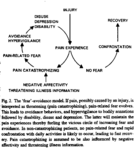
Vlaeyen JWS, Linton SJ Fear-avoidance and its consequences in chronic musculoskeletal pain: a state of th art. Pain 2000;85:317-332
fear-avoidanceについてのreview 英文なので読むのに時間がかかった
- Fear-avoidance, which refers to the avoidance of movements or activities based on fear, has been put forth as a central mechanism in the development of long-term back pain proglem.
- fear and anxiety influence the experience of pain, and chronic pain disability.
- avoidance learning occurs when the undesirable event has benn successfully avoided by the performance of a certain behabior.
- negative appraisals about pain and its consequences, such as catastrophic thinking, is considered a potential precursor of pain-related fear.
- Because avoidance behaviors occur in anticipation of pain rather than as a response to pain, these behaviors may persist because there are fewer oppotrtunities to correct the wrongful expectancies and beliefs about pain as a signal of threat of physical integrity.
- choronic back pain patients with high anxiety sensitivity reported more fear of pain and tended to have greater avoidance of activities than those with lower anxiety sensitivity, despite equal levels of pain.
- anxious patients showed a tendency to overpredict pain early in the sequence of pain, while the low anxious patients underpredicted pain.
- there is considerable evidence that pain-related fear not only leads to poor physical performance as measured in the laboratory, but the these effects also generalize to activities of daily life including activities at the workplace. In addition, fear-avoidance beliefs may be an important predictor of pain episodes early on in pain-free people.
- pain-related fear may also be responsible for the worsened physical condition and the occurrence of guarded movement patterns displayed by a number ofchronic musculoskeletal pain patients. These effects are probably mediated by avoidance behaviors and poor physical performance, which are considered as the more immediate consequences of pain-related fear.
- In terms of screening, both the TSK and FABQ are relatively short questionnaires that are appropriate for use in a primary as well as secondary care setting.
- Graded exposure to the situations the patients has identified as dangerous or threatening.
- In conclusion, The idea that fear of pain and reinjury may be more disabling thah pain itself refutes the early notion that the lowered ability to accomplish tasks of daily living in chronic pain patients is merely the sonsequenceo fo pain severity.
- pain-related fear is indeed one of the most potent predictors of observable physical performance and self-reported disability levels.